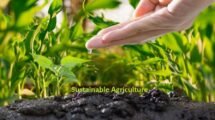Raliya’s ‘Nano Urea’ invention could save India $40 billion in fertilizer subsidies and imports.
Ramesh Raliya, now 34, grew up in the dry village of Kharia Khangar, 90 km from Jodhpur. Only four months of the year were good for farming there. The rain-fed kharif crops of millets and legumes barely provided enough food for Raliya’s father and eight siblings to live on. His mother also worked as a seamstress.
She walked barefoot through the muddy streets with a sewing machine on her head. Near the village, there was a white cement factory township that gave her a good amount of business. She also used her sewing skills to turn fertiliser bags into school bags for her kids. The family’s hard times would only get better if farming became a year-round job or if the crops grew by some miracle.
Since he was a child, these two main questions have been on Raliya’s mind, and they still drive his scientific research. Only now, he cares about more than just his own family. He also cares about the poor farmers of India.
Also Read | Scientists questioned ‘Nano Urea’ technology’s effectiveness on crop benefits.
A subsidy cutter
Raliya is a multidisciplinary biotechnology scientist who is known all over the world. She has ten patents for her work on making new inorganic and organic nanoparticles. His invention of nano urea in liquid form could save India nearly $40 billion in fertiliser subsidies and imports. It could also help farmers make more money and protect the environment from damage caused by the careless use of agrochemicals.
Even though some of the top crop science multinationals offered to buy Raliya’s patent for $10 million plus a guaranteed annual salary of $300,000, he chose to give a free licence to IFFCO, the country’s largest fertiliser co-operative with sales of more than ₹30,000 crore, so that Indian farmers could get the nutrient at a low price. ‘But if someone wanted to licence it, my condition was that farmers should be able to buy nano-urea at cost or the lowest price possible,’ says Raliya.
Instead of throwing granular urea on the soil, Raliya’s patented nano urea can be sprayed directly on the leaves of a crop during two important growth stages. A 45 kg bag of urea can be replaced by a 500 ml bottle of nano urea. ‘Taking nano urea is like getting an IV injection instead of a pill. The leaf is a better way for the ultra-small particles to get into the plant than the soil. More than 70% of the conventional urea that is spread on the soil is not taken up by plants and goes to waste. It makes the soil acidic and the runoff ends up polluting water bodies,’ says Raliya, who recently quit as IFFCO’s general manager and head of R&D but still works as a consultant for the cooperative to help it scale up commercial production of nano urea.
Protecting the Soil
Urea is a type of fertiliser that plants use to get nitrogen so they can grow and get bigger. Nitrogen is the most important ingredient in amino acids, enzymes, DNA, RNA, and chlorophyll. The amount of nitrogen in a healthy plant is usually between 1.5% and 4%. Since nano nitrogen particles are spread out in nano urea as a liquid, they start working almost right away when sprayed on leaves to meet the crop’s nutritional needs and open up pathways for nitrogen uptake and assimilation. And it costs almost nothing. A bottle of nano urea costs ₹240, and the price stays low without any help from the government. On the other hand, a subsidised bag of urea costs about ₹270, while the price on the market is close to ₹2,600.
About 60 million tonnes of fertilisers are used every year in India. The government spends about ₹7,000 per farmer on fertiliser subsidies, or nearly ₹1 lakh crore per year. This often gives farmers a bad reason to use them everywhere, which makes the soil less fertile, hurts the environment, and makes the food chain toxic. Punjab, for example, uses 246 kg of fertiliser per hectare, which is more than the average of 135 kg used across the country.
India also doesn’t have enough of the raw materials to make a lot of fertilisers. There isn’t enough oil and gas to make them. India gets most of its raw materials for making fertiliser from Russia and the Ukraine. This year, because of the war in Ukraine, a bag of urea costs almost ₹3,000.
Also Read | India’s first nano urea plant in Bangalore with investment of ₹350 cr – IFFCO.
Nearly 14 million tonnes of subsidised urea can be replaced by liquid nano urea. This will save the country close to $40 billion in imports and cut down on logistics and storage costs by a large amount. Trials done in India on almost 40 crops in more than 11,000 different places show that nano urea can boost crop yields by up to 24% in grains and 8% in fruits and vegetables.
One of the main goals of the government’s agriculture policy is to get more people to use nano-urea so that traditional granular fertilisers can be phased out.
IFFCO has already made more than 3.6 billion bottles of nano urea at its plant and sold almost 3 billion bottles to farmers. In the next two years, the Indian government will spend ₹3,000 crore to build 11 more plants across the country. These plants will make 44 million bottles of nano urea or about 20 million tonnes of regular urea. (Inputs from Agency)


















Add Comment